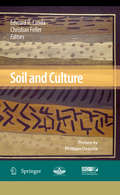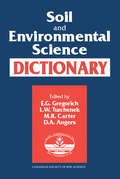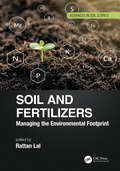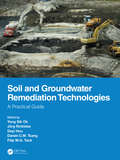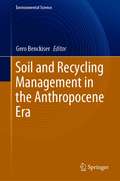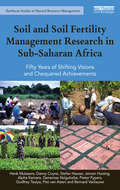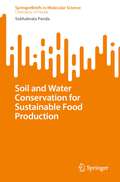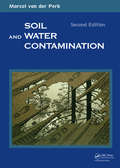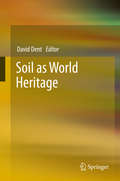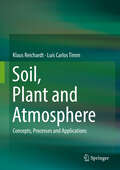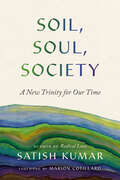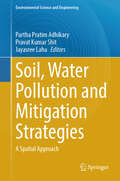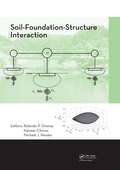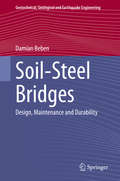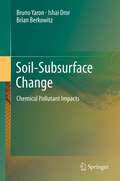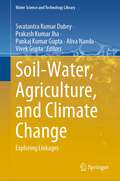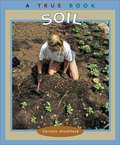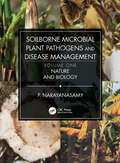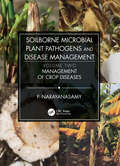- Table View
- List View
Soil and Culture
by Christian Feller Edward R. LandaSOIL: beneath our feet / food and fiber / ashes to ashes, dust to dust / dirt!Soil has been called the final frontier of environmental research. The critical role of soil in biogeochemical processes is tied to its properties and place--porous, structured, and spatially variable, it serves as a conduit, buffer, and transformer of water, solutes and gases. Yet what is complex, life-giving, and sacred to some, is ordinary, even ugly, to others. This is the enigma that is soil. Soil and Culture explores the perception of soil in ancient, traditional, and modern societies. It looks at the visual arts (painting, textiles, sculpture, architecture, film, comics and stamps), prose & poetry, religion, philosophy, anthropology, archaeology, wine production, health & diet, and disease & warfare. Soil and Culture explores high culture and popular culture--from the paintings of Hieronymus Bosch to the films of Steve McQueen. It looks at ancient societies and contemporary artists. Contributors from a variety of disciplines delve into the mind of Carl Jung and the bellies of soil eaters, and explore Chinese paintings, African mud cloths, Mayan rituals, Japanese films, French comic strips, and Russian poetry.
Soil and Environmental Science Dictionary
by E. G. Gregorich L. W. Turchenek M. R. Carter D. A. AngersThe lingo of soil science is a language unto itself. Soil and Environmental Science Dictionary is a glossary of terms used in soil and environmental science, including terms from related disciplines. Designed for teachers, students, researchers and others interested or involved in environmental sciences related to soils, this compilation includes a
Soil and Fertilizers: Managing the Environmental Footprint (Advances in Soil Science)
by Rattan LalSoil and Fertilizers: Managing the Environmental Footprint presents strategies to improve soil health by reducing the rate of fertilizer input while maintaining high agronomic yields. It is estimated that fertilizer use supported nearly half of global births in 2008. In a context of potential food insecurity exacerbated by population growth and climate change, the importance of fertilizers in sustaining the agronomic production is clear. However, excessive use of chemical fertilizers poses serious risks both to the environment and to human health. Highlighting a tenfold increase in global fertilizer consumption between 2002 and 2016, the book explains the effects on the quality of soil, water, air and biota from overuse of chemical fertilizers. Written by an interdisciplinary author team, this book presents methods for enhancing the efficiency of fertilizer use and outlines agricultural practices that can reduce the environmental footprint. Features: Includes a thorough literature review on the agronomic and environmental impact of fertilizer, from degradation of ecosystems to the eutrophication of drinking water Devotes specific chapters to enhancing the use efficiency and effectiveness of the fertilizers through improved formulations, time and mode of application, and the use of precision farming technology Reveals geographic variation in fertilizer consumption volume by presenting case studies for specific countries and regions, including India and Africa Discusses the pros and cons of organic vs. chemical fertilizers, innovative technologies including nuclear energy, and the U.N.’s Sustainable Development Goals Part of the Advances in Soil Sciences series, this solutions-focused volume will appeal to soil scientists, environmental scientists and agricultural engineers.
Soil and Groundwater Remediation Technologies: A Practical Guide
by Yong Sik Ok; Jörg Rinklebe; Deyi Hou; Daniel C.W. Tsang; Filip M.G. TackThis book offers various soil and water treatment technologies due to increasing global soil and water pollution. In many countries, the management of contaminated land has matured, and it is developing in many others. Topics covered include chemical and ecological risk assessment of contaminated sites; phytomanagement of contaminants; arsenic removal; selection and technology diffusion; technologies and socio-environmental management; post-remediation long-term management; soil and groundwater laws and regulations; and trace element regulation limits in soil. Future prospects of soil and groundwater remediation are critically discussed in this book. Hence, readers will learn to understand the future prospects of soil and groundwater contaminants and remediation measures.Key Features: Discusses conventional and novel aspects of soil and groundwater remediation technologies Includes new monitoring/sensing technologies for soil and groundwater pollution Features a case study of remediation of contaminated sites in the old, industrial, Ruhr area in Germany Highlights soil washing, soil flushing, and stabilization/solidification Presents information on emerging contaminants that exhibit new challenges This book is designed for undergraduate and graduate courses and can be used as a handbook for researchers, policy makers, and local governmental institutes. Soil and Groundwater Remediation Technologies: A Practical Guide is written by a team of leading global experts in the field.
Soil and Recycling Management in the Anthropocene Era (Environmental Science and Engineering)
by Gero BenckiserThis book discusses soil and recycling management in the Anthropocene era. Nitrogen shortage is one of nature’s most important productivity regulators, but since the advent of technical nitrogen fixation (TNF), biological nitrogen fixation (BNF) input has nearly doubled, particularly in grass and arable lands covering over 13 million km2 of the Earth’s surface. This book explores how monoculture grass, arable lands and forests are often over fertilized with TNF, animal slurries, sewage sludge, or municipally produced composts, and as a result, flora and fauna that have adapted to a nitrogen shortage in the soil will have to adjust to a surplus; those that are unable to adapt will disappear.
Soil and Soil Fertility Management Research in Sub-Saharan Africa: Fifty years of shifting visions and chequered achievements (Earthscan Studies in Natural Resource Management)
by Bernard Vanlauwe Generose Nziguheba Danny Coyne Henk Mutsaers Stefan Hauser Jeroen Huising Alpha Kamara Pieter Pypers Godfrey Taulya Piet van AstenJudicious soil fertility management is crucial for sustainable crop production and food security in sub-Saharan Africa (SSA). This book describes the various concepts and approaches underlying soil and soil fertility management research in SSA over the last fifty years. It provides examples of important innovations generated and assesses the position of research within the research-to-development continuum, including how innovations have been validated with the intended beneficiaries. Using the experience of the International Institute of Tropical Agriculture (IITA) as a case study, the authors analyse how processes, partnerships and other factors have affected research priorities, the delivery of outputs, and their uptake by farming communities in SSA. They evaluate both successes and failures of past investments in soil fertility research and important lessons learnt which provide crucial information for national and international scientists currently engaged in this research area. The book is organised in a number of chapters each covering a chronological period characterised by its primary research content and approaches and by the dominant research paradigms and delivery models.
Soil and Water Conservation for Sustainable Food Production (SpringerBriefs in Molecular Science)
by Subhabrata PandaThis book addresses the impact of soil and water quality on food production, and explores soil and water conservation measures to be applied at farm level for agricultural sustainability. Divided into 8 chapters, the book covers topics such as soil properties responsible for soil loss, the impact of climate change, water and biological factors on soil chemistry, the effect of soil on the quality of water including sustaining aquaculture productivity and environment of wetlands, soil and water qualities necessary for irrigation, management of soil organic carbon, and the importance of soil moisture conservation including agroforestry for food production. Particular attention is given to the management of soil organic carbon in sustainable crop cultivation as well as reducing soil erosion and nutrient loss from soil from cultivated lands. The book concludes with a chapter that integrates soil and water conservation with sustainable food production and food safety.
Soil and Water Contamination
by Marcel van PerkSoil and Water Contamination, Second Edition gives a structured overview of transport and fate processes of environmental contaminants. Providing a structured overview of transport and fate processes of environmental contaminants, this textbook approaches the environmental issues of soil and water contamination from a spatial and earth science point of view. The new edition contains new material on pesticides and pharmaceutical contaminants and a greater number of exercises, case studies, and examples. It covers topics essential to understanding and predicting contaminant patterns in soil, groundwater, and surface water and contributes to the formation of a solid basis for adequate management and control of soil and water pollution and integrated catchment.
Soil as World Heritage
by David DentSoil as World Heritage celebrates a half century of field experiments on the Balti Steppe, in Moldova - where Dokuchaev first described the Typical Chernozem in 1877, protected from the elements by a unique system of shelter belts designed by the great man, and now provisionally listed as the first World Heritage Site for soil. The book presents contributions to the 2012 international symposium attended by researchers, practitioners and policy makers from the European Commission and countries as diverse as Belarus, Bulgaria, the Czech Republic, France, Germany, Italy , the Netherlands, Romania, Russia, Ukraine, United Kingdom, USA and, of course, Moldova itself. The experimental data demonstrate the damage caused by human activity to the productivity and integrity of the black earth and, also, ways to restore its fertility. Results from even longer-established trials worldwide also demonstrate that agricultural practices are driving global warming, leaching of nutrients, pollution of water resources, diversion of rainfall away from replenishment of soil and groundwater to destructive runoff, and destroying soil organic matter and biodiversity. These are pressing issues for our generation and will press harder on future generations. Long-term field experiments, and the scientific skills and experience that they nurture, will be more and more valuable as a foundation and focus for interdisciplinary teams studying the effects of farming practices on the soil and soil life so as to devise a sustainable alternative. Europe-wide and worldwide contributions also discuss economic incentives - carbon and green water credits - which themselves require robust supporting data, and legislative aspects of promoting more sustainable farming systems. The outcomes of the conference include recommendations for institutional support for sustainable farming and a draft of the law on land and soil management for the Parliament of Moldova.
Soil behaviour and critical state soil mechanics
by David Muir WoodSoils can rarely be described as ideally elastic or perfectly plastic and yet simple elastic and plastic models form the basis for the most traditional geotechnical engineering calculations. With the advent of cheap powerful computers the possibility of performing analyses based on more realistic models has become widely available. One of the aims of this book is to describe the basic ingredients of a family of simple elastic-plastic models of soil behaviour and to demonstrate how such models can be used in numerical analyses. Such numerical analyses are often regarded as mysterious black boxes but a proper appreciation of their worth requires an understanding of the numerical models on which they are based. Though the models on which this book concentrates are simple, understanding of these will indicate the ways in which more sophisticated models will perform.
Soil in Criminal and Environmental Forensics
by Henk Kars Lida EijkelThis introductory volume to a new series on Soil Forensics gives a kaleidoscopic view of a developing forensic expertise. Forensic practitioners and academic researchers demonstrate, by their joint contributions, the extent and complexity of soil forensics. their reports exemplify the broad range of sciences and techniques applied in all stages of forensic soil examinations, from investigations at crime scenes to providing evidence that can be used in court proceedings. Moreover the necessity is depicted of co-operation as a condition for any work in soil forensics between scientists of different disciplines, but no less between scientists and law enforcers. Soils play a role in environmental crimes and liability, as trace evidence in criminal investigations and, when searching for and evaluating, buried human remains. This book shows soil forensics as practiced in this legal context, emerging and solidifying in many countries all over the world, differing in some respects because of differences in legal systems but ultimately sharing common grounds.
Soil mechanics
by David Muir WoodThis 2009 book teaches the principles of soil mechanics to undergraduates, along with other properties of engineering materials, to which the students are exposed simultaneously. Using the critical state method of soil mechanics to study the mechanical behavior of soils requires the student to consider density alongside effective stresses, permitting the unification of deformation and strength characteristics. This unification aids the understanding of soil mechanics. This book explores a one-dimensional theme for the presentation of many of the key concepts of soil mechanics - density, stress, stiffness, strength, and fluid flow - and includes a chapter on the analysis of one-dimensional consolidation, which fits nicely with the theme of the book. It also presents some theoretical analyses of soil-structure interaction, which can be analyzed using essentially one-dimensional governing equations. Examples are given at the end of most chapters, and suggestions for laboratory exercises or demonstrations are given.
Soil to Foil: Aluminum and the Quest for Industrial Sustainability
by Saleem AliAluminum is the most abundant metal in the earth’s crust. It is also ubiquitous in the modern world, from aircraft to soda cans. A dizzying number of consumer and industrial products employ aluminum, typically alloyed, because of its availability, versatility, and malleability. Today, how efficiently we use—and reuse—aluminum is vital to addressing key environmental challenges and understanding humanity’s fraught relationship with the earth.Soil to Foil tells the extraordinary story of aluminum. Saleem H. Ali reveals its pivotal role in the histories of scientific inquiry and technological innovation as well as its importance to sustainability. He offers compelling portraits of the scientists and innovators who discovered new uses for this remarkable element, ranging from chemistry and geoscience to engineering and industrial design. Ali argues that aluminum exemplifies broader lessons about stewardship of nonrenewable resources: its seeming abundance has given rise to wasteful and destructive practices. Soil to Foil follows aluminum’s path along the supply chain, from extraction to production, consumption to recycling. Ali explores the ecological damage at mine sites and visits affected communities seeking to restore the land. He foregrounds the possibilities for more sustainable industrial practices, emphasizing how product design can incorporate eventual reuse and recycling. Ultimately, Soil to Foil shows that the story of aluminum’s use and misuse helps us rethink how to sustainably manage the resources of our planet.
Soil, Plant and Atmosphere: Concepts, Processes and Applications
by Klaus Reichardt Luís Carlos TimmThis textbook presents the concepts and processes involved in the soil-plant-atmosphere system as well as its applications in the water cycle in agriculture. Although reaching the frontier of our knowledge in several subjects, each chapter starts at the graduation level and proceeds to the post-doctoral level. Its more complicated subjects, as math and physics, are well explained, even to readers not well acquainted with these tools. Therefore, it helps students read, understand, and developing their thoughts on these subjects. Instructors also find it an easy book with the needed depth to be adopted in courses related to Soil Physics, Agricultural Management, Environmental Protection, Irrigation and Agrometeorology. It serves also as “lexicon” to engineers and lawyers involved in agricultural, environmental cases.
Soil, Soul, Society: A New Trinity for Our Time
by Satish KumarIn the first US edition of Satish Kumar's classic book, we rediscover how our spiritual and social well-being connects to that of our planet.Internationally-respected peace and environment activist Satish Kumar has been gently setting the agenda for change for over 50 years. As 350.org founder Bill McKibben says, "There is no one on the planet better-equipped to make you think and rethink how you're living and how you might change." The age of sustainability is grounded on the knowledge that we ourselves are very much part of nature; that what we do to nature we in fact do to ourselves; and that the earth has a soul, which we share. Drawing on the example of Rabindranath Tagore, Kumar advocates living with awareness that our personal choices have political and poetic resonance. In this book, he inspires readers with the knowledge we are all leaders and can create change in our structures and mindsets for lasting peace and a sustainable culture and society. Celebrating an emerging global consciousness that reveres nature, the book explores how, as a global society, we need to embrace diversity and be aware of our role as pilgrims on this earth. Joyful and heart-centered, Satish Kumar reminds us that to bring about change in the world, we must embody the change we wish to see.
Soil, Water Pollution and Mitigation Strategies: A Spatial Approach (Environmental Science and Engineering)
by Pravat Kumar Shit Partha Pratim Adhikary Jayasree LahaDive into the dynamic world of environmental stewardship with "Soil, Water Pollution, and Mitigation Strategies: A Spatial Approach." This meticulously crafted volume offers a comprehensive journey through the measurement, monitoring, mapping, and modelling of soil and water pollution, coupled with innovative mitigation strategies. Discover cutting-edge techniques rooted in modern geospatial methodologies, with a sharp focus on the latest trends in data mining and robust modelling. As our planet grapples with the consequences of anthropogenic activities, such as indiscriminate chemical usage in agriculture, the need for precise quantification and risk assessment has never been more urgent. This book serves as a beacon, illuminating the path toward sustainable management of soil and water resources through the lens of geospatial technology. Explore a myriad of critical topics, including soil microbiology, salinity, pollution from industrial sources, heavy metals, and the pervasive impact of agricultural practices. Delve into environmental risk assessment, sustainable land use, and innovative remediation techniques, such as harnessing the power of Plant Growth-Promoting Rhizobacteria (PGPR) and embracing organic fertilizers. Written for researchers, professionals, and policymakers alike, this book offers invaluable insights into the complex interplay between human activity and environmental health. Organized into two parts (I) Soil Contaminants, Risk Assessment, and Mitigation, and (II) Water Contaminants, Risk Assessment, and Mitigation—it provides a structured approach to understanding and addressing environmental challenges. Each chapter serves as a portal to a deeper understanding of the issues at hand, presenting a synthesis of current research, identifying future directions, and offering pragmatic solutions. This book promises to enrich the understanding of environmental science and empower the reader with the knowledge and skills needed to effect positive change. Designed to cater to a diverse audience—from students and researchers in environmental sciences to policymakers, NGOs, and corporate stakeholders—this book is a testament to the collaborative effort required to safeguard our planet's precious resources. This is a transformative journey toward a more sustainable future—one informed by science, guided by innovation, and driven by a shared commitment to environmental stewardship.
Soil-Foundation-Structure Interaction: A Special Issue Of The International Journal Of Human-computer Interaction
by James R. LewisSoil-Foundation-Structure Interaction contains selected papers presented at the International Workshop on Soil-Foundation-Structure Interaction held in Auckland, New Zealand from 26-27 November 2009. The workshop was the venue for an international exchange of ideas, disseminating information about experiments, numerical models and practical en
Soil-Specific Farming: Precision Agriculture (Advances in Soil Science)
by Rattan Lal B. A. StewartFaced with challenges of resource scarcity and environmental degradation, it is important to adopt innovative farming systems that maximize resource efficiency while protecting the environment. Soil-Specific Farming: Precision Agriculture focuses on principles and applications of soil-specific farming, providing information on rapidly evolving agri
Soil-Steel Bridges: Design, Maintenance and Durability (Geotechnical, Geological and Earthquake Engineering #49)
by Damian BebenThe primary objective of this book is to provide designers with a set of analysis and design specifications for soil-steel bridges and culverts, also called flexible structures. Brief but informative, this guide is based on a quick look up approach to code applications, design and analysis methods/calculations as well as applications and solved examples. The book addresses the unique aspects of soil-steel bridges: design and analysis as well as examples of applications, numerical analysis and modeling techniques, corrosion and durability problems, service life and maintenance, and impact of moving loads.
Soil-Subsurface Change
by Brian Berkowitz Bruno Yaron Ishai DrorThis book combines soil science, earth science, and environmental geochemistry, providing comprehensive background information for specialists interested in chemical-induced changes in the soil-subsurface system. Readers are introduced to the chemistry of contaminants that often disturb the natural soil-subsurface equilibrium as a result of human activity. While the soil-subsurface system has in many cases been affected by human impact, the effects of chemical contaminants on the actual matrix and properties have been largely neglected. The major focus of the book is on changes to the soil-subsurface matrix and properties caused by chemical pollution. By integrating results available in the literature, we observe that chemical pollutants may lead to the irreversible formation of a new soil-subsurface regime characterized by a matrix and properties different than those of the natural regime. In contrast to the geological time scales dictating natural changes to the matrix and properties of the soil-subsurface system, the time scale associated with chemical pollutant-induced changes is far shorter and extends over a "human lifetime scale." The numerous examples presented in the book confirm that chemical contamination should be considered as an additional factor in the formation of a contemporary soil-subsurface regime that is different than that of the pristine system.
Soil-Water, Agriculture, and Climate Change: Exploring Linkages (Water Science and Technology Library #113)
by Pankaj Kumar Gupta Swatantra Kumar Dubey Prakash Kumar Jha Aliva Nanda Vivek GuptaThis book presents an exploration of linkages among soil-water, agriculture, and climate change with a special focus on thematic areas for assessment, mitigation, and management of natural resources under climate change conditions. This book covers advances in modelling approaches, including machine learning (ML)/ artificial intelligence (AI) applications; GIS and remote sensing; sensors; impacts of climate change on agriculture; subsurface water; contaminants; and socio-economic impacts, which are lacking in a more comprehensive manner in the previous titles. This book encompasses updated information as well as future directions for researchers working in the field of management of natural resources. The goal of this book is to provide scientific evidence to researchers and policymakers and end-to-end value chain practitioners which may help in reducing the overall adverse impacts of climate change on water resources and the related mitigation strategies. This book focuses on the knowledge, modern tools, and techniques, i.e., machine learning, artificial intelligence, etc. for soil-water, agriculture, and climate change. Further, nature-based solutions for management of natural resources with special targets on contaminants, extreme events, disturbances, etc. will be targeted. The book provides readers with the enhanced knowledge for application of engineering principles and economic and regulatory constraints to determine a soil-water, agriculture production action strategy, and select appropriate technologies to implement the strategy for a given data set at a site. It would also cover the application of laboratory, modeling, numerical methods for determination and forecasting of climate change impacts, agriculture production, pollution, soil health, etc. Overall, it provides hydrologists, environmental engineers, administrators, policy makers, consultants, and industrial experts with essential support in effective management of soils health, agricultural productions, and mitigation of extreme climatic events.
Soil: A True book
by Christin DitchfieldPresents information about soil, including its composition, properties, and some of its uses.
Soilborne Microbial Plant Pathogens and Disease Management, Volume One: Nature and Biology
by P. NarayanasamySoilborne microbial plant pathogens including oomycetes, fungi, bacteria and viruses cause several economically important destructive diseases and the symptoms of infection can be recognized only after the pathogen has invaded many tissues primarily vascular tissues of susceptible plants. This condition places formidable challenges in investigating different aspects of host-microbial pathogen interactions. Early detection of infection and precise identification, differentiation, and quantification of the microbial plant pathogens in plants, soil and water sources are essential requirements for development of effective tactics to reduce the incidence and spread of the diseases caused by them. As the microbial plant pathogens differ in their virulence and sensitivity to the environment and chemicals applied, it is imperative to assess the extent of variability in the concerned pathogens. This first volume of a two-volume set introduces disease-causing microorganisms including oomycetes, fungi, bacteria, and viruses found in soils. It focuses on the biology, detection, and identification of soilborne bacterial, fungal, and viral plant pathogens. This volume discusses various techniques based on biological, immunological and genetic properties of the pathogens indicating their advantages and limitations for selecting the appropriate technique to fulfill the requirements. Features: Presents techniques useful for detection, identification, quantification of microbial plant pathogens in plants, soil, and irrigation water from waterbodies. Highlights subversive activities of viruses, resulting in the breakdown of host defense systems. Discusses RNA silencing in infected plants by viruses and posttranscriptional gene silencing (PTGS) functioning as an endogenous mechanism in plants against virus infection. Presents information on methods of assessment of genetic variability and sensitivity of microbial plant pathogens to chemicals and adverse environmental conditions.
Soilborne Microbial Plant Pathogens and Disease Management, Volume Two: Management of Crop Diseases
by P. NarayanasamyCrop disease management strategies revolve around the principles of exclusion, eradication and immunization. Cultural practices are aimed at preventing or reducing the accumulation of pathogen population (inoculum). Development of cultivars with genetic resistance by transgressing resistance gene(s) through traditional breeding procedures or biotechnological techniques is the most effective and acceptable strategy, as it is environment-friendly and does not need any additional cost to the grower. Assessment of different grades of resistance of cultivars or genotypes to soilborne microbial pathogens has been possible by quantifying pathogen populations or their DNA contents in the test plants by applying biological and molecular methods. This second volume of a two-volume set focuses on the soilborne microbial plant pathogens and the diseases caused by them. The book provides information on ecology and epidemiology of soilborne microbial plant pathogens and various strategies applicable for effective management of diseases. Chapters cover exclusion and prevention strategies; improvement of host plant resistance; biological management; application of chemicals; and integration of these disease management strategies. Features Discusses various aspects of soilborne microbial plant pathogens to develop effective methods of managing diseases. Presents information on epidemiology and ecology of soilborne microbial plant pathogens. Facilitates the application of management strategies alone or in combination with others for effective suppression of disease development. Features information on application of biotic and abiotic biological control agents (BCAs) to suppress pathogen development either by directly acting on the pathogen(s) or indirectly by enhancing host resistance to the pathogens. Employs biotic and abiotic biocontrol agents either to replace or reduce the use of chemicals is an achievable approach for managing the soilborne microbial pathogens.
Soils
by Randall J. Schaetzl Michael L. ThompsonSoils: Genesis and Geomorphology is a comprehensive and accessible textbook on all aspects of soils. The book's introductory chapters on soil morphology, physics, mineralogy and organisms prepare the reader for the more advanced and thorough treatment that follows. Theory and processes of soil genesis and geomorphology form the backbone of the book, rather than the emphasis on soil classification that permeates other less imaginative soils textbooks. This refreshingly readable text takes a truly global perspective, with many examples from around the world sprinkled throughout. Replete with hundreds of high quality figures and a large glossary, this book will be invaluable for anyone studying soils, landforms and landscape change. Soils: Genesis and Geomorphology is an ideal textbook for mid- to upper-level undergraduate and graduate level courses in soils, pedology and geomorphology. It will also be an invaluable reference text for researchers.
